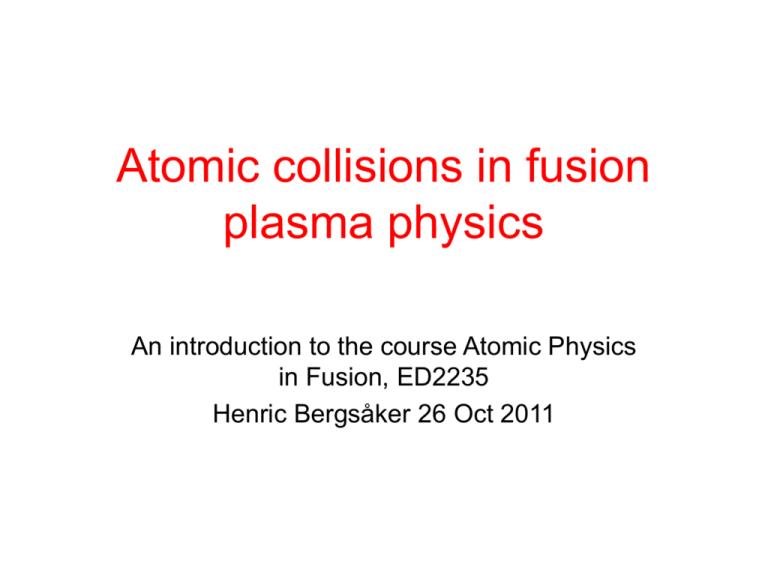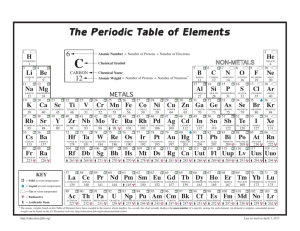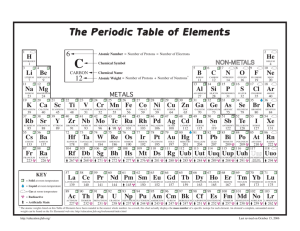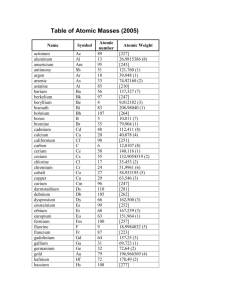Introduction (ppt 2.6 MB)
advertisement

Atomic collisions in fusion plasma physics An introduction to the course Atomic Physics in Fusion, ED2235 Henric Bergsåker 26 Oct 2011 Atomic collisions in fusion • Atomic collisions and plasma performance Plasma resistivity and ohmic heating Radiative cooling Transport Collisions in edge plasma physics Ion implantation and backscattering at surfaces Sputtering at surfaces • • • • • Diagnostics involving atomic collisions Types of collisions Classical mechanics vs Quantum mechanics Key quantities Course outline and schedule Plasma resistivity The plasma resistivity is due to elastic collisions me1/ 2 e2 ln s 0.51 2 3/ 2 3 0 (2 Te ) E J s 2 n Z j j j n Z j j j s Z eff P j 2 Radiation losses Ploss LZ ne nz Z In a low density plasma the charge state distribution and radiating power density depends on electron impact ionisation and excitation. Plots: Y. Ding, Master thesis KTH 2008 Transport and collisions Classical diffusion Neoclassical diffusion D D 2 c q2 2 3/ 2 c Parallel transport on open field lines is important for impurity control with a divertor. Impurities created in the divertor are confined there by the collisional friction drag by the majority ion flow towards the divertor plates. Backscattering at surfaces Upper: H -> C W.Eckstein et al. Lower: C -> C H. Bergsåker et al. Ion implantation W. Eckstein et al. 2005 Physical sputtering Upper: few collisions view, J. Bohdansky. Lower: Monte-Carlo (TRIM), W Eckstein et al. Modelling of deposition in castellation gaps. Experiments in TEXTOR A. Litnovsky et al. , PSI San Diego X-ray tomography m/n=1 mode behaviour during sawtooth activity in the HT-7 tokamak. T.P. Ma et al. Phys. Lett. A361(2007)136. Neutral particle analysis The central ion temperature can be measured by neutral particle analysis. M. Bagatin et al. Fus. Eng. Design 25(1995)425. Charge exchange spectroscopy Studies of fully stripped O following H0+O8+ -> H++(O7+)* R.C. Isler et al. Nucl Inst. Meth. B9(1985)673. Charge exchange spectroscopy Fast CXRS in JT-60U. Measurements of Ti and grad Ti using a line in the C5+ spectrum After H0+C6+ -> H++(C5+)* M. Yoshida et al. Fus. Eng. Des. 2009 in press. Impurity and H flux from emission spectroscopy The images show hydrocarbon emission from the divertor region of DIII-D. In principle the flux density of neutrals entering the plasma can be measured spatially resolved in this way. M. Groth et al. J.Nucl.Mater 363-365(2007)157. Atomic beam edge diagnostics Observation of three lines in neutral He. The intensity ratios give both Te and ne B. Schweer et al. J.Nucl.Mater. 266269(1999)673. Important types of collisions • • • • • • • e H e H H AH A Elastic collision e H e H h Bremsstrahlung HA H A h Electron impact ionisation e H (1s) e e H e H (i ) e H ( f ) Electron impact excitation Radiative recombination e H H h A h Dielectronic recombination e A A Charge transfer H H H H HA H A h q ( q 1) q ( q 1) ** ( q 1) * q ( q 1) Classical vs Quantum mechanics Intended learning outcomes Having completed the course you should be able to: • Recall definitions of basic concepts in atomic physics and the size of key atomic quantities • Apply methods of wave mechanics and classical mechanics&electrodynamics to problems in atomic physics • Explain the significance of different approximations when estimating atomic quantities • Predict the general behaviour of fusion relevant atomic physics quantities based on dominating physical mechanisms • Construct simple numerical or analytic models of fusion plasma phenomena with input from atomic physics databases • Present and discuss fusion related atomic physics material, both in writing and orally Schedule Tentative schedule sem = seminar room 1419, Teknikringen 31 kosm= kosmos, top floor Henric Bergsåker, henricb@kth.se, 08-7906094, 073 9850300 Examination • Five assignments, solving problems and discussing fusion plasma physics issues involving atomic physics (50%) • Presentations (10%) • Final written examination: basic facts, solving problems, discuss the physics (40%)





